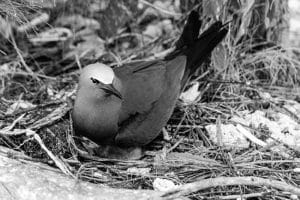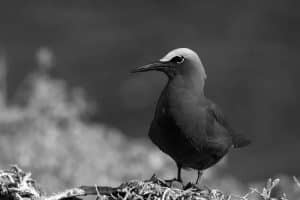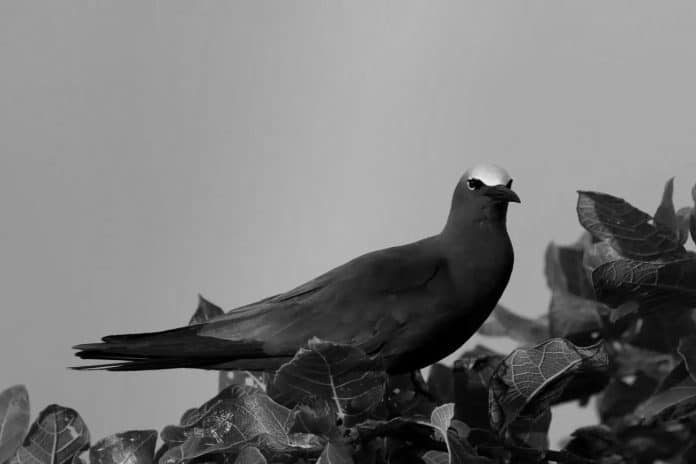Introduction to the Brown Noddy in Tanzania
The Brown Noddy in Tanzania (Anous stolidus) is a medium-sized seabird that belongs to the tern family. It is known for its striking appearance, with a dark brown body, white cap, and a yellowish-brown bill. The species is commonly found in tropical and subtropical regions around the world, including the Zanzibar Archipelago in Tanzania.
Habitat and Distribution of the Brown Noddy

The Brown Noddy prefers to inhabit tropical and subtropical coastal areas, including islands and coral atolls. In Tanzania, it can be found on the Zanzibar Archipelago, which consists of several islands, including Unguja and Pemba. These islands provide ideal nesting sites for the Brown Noddy, with their rocky cliffs and sandy beaches.
Physical Characteristics of the Brown Noddy
The Brown Noddy is a medium-sized seabird, measuring about 35 centimeters in length. It has a wingspan of approximately 70 centimeters. As mentioned earlier, it has a dark brown body with a white cap on its head. Its beak is yellowish-brown, and its eyes are dark. The Brown Noddy has long, pointed wings and a deeply forked tail, which aids in its agile flight over the open ocean.
Breeding Behavior and Life Cycle of the Brown Noddy
The breeding season for the Brown Noddy in Tanzania typically begins in the early months of the year. During this time, the birds form large colonies on the cliffs and rocky outcrops of the Zanzibar Archipelago. The nests are built close together, often in crevices or on ledges. The female lays a single egg, which is incubated by both parents for about 30 days.
Once the chicks hatch, they are cared for by their parents. The parents take turns feeding the chicks with small fish and squid that they catch in the surrounding waters. The chicks grow rapidly and develop their flight feathers after about six weeks. By the time they are two months old, they are capable of flying and become independent from their parents.
Migration Patterns and Conservation Status of the Brown Noddy in Tanzania

The Brown Noddy is a migratory species, with individuals from Tanzania often traveling long distances to their wintering grounds in the southern hemisphere. They are known to undertake impressive journeys, covering thousands of kilometers. However, some individuals may also remain in Tanzania year-round.
In terms of conservation status, the Brown Noddy is considered to be of least concern according to the International Union for Conservation of Nature (IUCN). However, like many seabird species, the Brown Noddy faces threats such as habitat loss, pollution, and disturbance from human activities. Efforts are being made to protect their nesting sites and raise awareness about the importance of conserving this species.
The Role of the Zanzibar Archipelago in Brown Noddy Conservation
The Zanzibar Archipelago plays a crucial role in the conservation of the Brown Noddy in Tanzania. The islands provide important breeding and nesting sites for these seabirds. The cliffs and rocky outcrops offer ideal locations for the birds to build their nests and raise their chicks. The archipelago’s protected areas and marine reserves also contribute to the conservation efforts by safeguarding the birds’ foraging grounds and reducing disturbance from human activities.
Unique Seabird Encounters on the Zanzibar Archipelago
Visiting the Zanzibar Archipelago offers the opportunity for unique seabird encounters, including sightings of the Brown Noddy. The archipelago is home to a rich diversity of seabird species, and the coastal cliffs and beaches provide excellent vantage points for observing these birds in their natural habitat. In addition to the Brown Noddy, visitors may spot other seabirds such as frigatebirds, tropicbirds, and terns.
Best Places to Spot Brown Noddies in Tanzania

If you’re interested in spotting Brown Noddies in Tanzania, there are several key locations where they can be commonly found. One of the best places is the Ngezi Forest Reserve on Pemba Island, which is known for its significant seabird colonies. Another hotspot is the Mnemba Island Marine Reserve, located off the coast of Zanzibar Island. This protected area is home to diverse marine life, including seabirds like the Brown Noddy.
Tips for Birdwatching and Photographing Brown Noddies
To make the most of your birdwatching and photography experience with the Brown Noddy, here are a few tips to keep in mind. Firstly, it’s important to respect the birds’ natural habitat and avoid disturbing them. Keep a safe distance and use binoculars or a telephoto lens to observe and capture their behavior. Be patient and observant, as these birds can be quite elusive and may require some time to spot. Lastly, consider joining a guided birdwatching tour led by experienced local guides who can provide valuable insights and help you locate the best vantage points.
Conservation Efforts and Organizations Working to Protect the Brown Noddy in Tanzania
Several organizations are actively involved in the conservation of the Brown Noddy in Tanzania. One such organization is the Zanzibar Bird Atlas, which conducts research on seabird populations and their habitats. They work closely with local communities and authorities to promote sustainable tourism practices and raise awareness about the importance of protecting these birds. Other organizations, such as the Wildlife Conservation Society and BirdLife International, also contribute to the conservation efforts through research, monitoring, and community engagement.
Conclusion
The Brown Noddy is a captivating seabird species that adds to the natural beauty of Tanzania, particularly the Zanzibar Archipelago. Its unique appearance, breeding behaviors, and migration patterns make it a fascinating subject for bird enthusiasts and nature lovers. By understanding the habitat, physical characteristics, and conservation status of the Brown Noddy, we can appreciate the importance of preserving its nesting sites and ensuring its long-term survival. Whether you’re a seasoned birdwatcher or a curious traveler, the Zanzibar Archipelago offers a remarkable opportunity to encounter these incredible seabirds and witness their natural wonders.

































